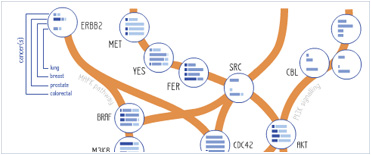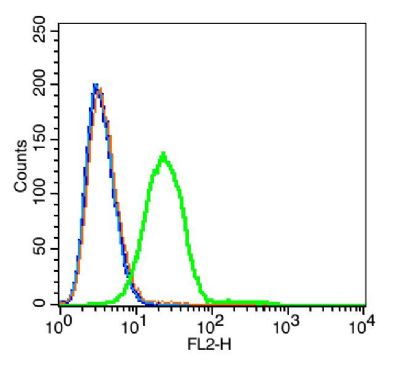GPR27 Polyclonal Antibody
Purified Rabbit Polyclonal Antibody (Pab)
- SPECIFICATION
- CITATIONS
- PROTOCOLS
- BACKGROUND

Application
| IHC-P, IHC-F, IF, ICC, E |
|---|---|
| Primary Accession | Q9NS67 |
| Reactivity | Rat, Bovine |
| Host | Rabbit |
| Clonality | Polyclonal |
| Calculated MW | 40 KDa |
| Physical State | Liquid |
| Immunogen | KLH conjugated synthetic peptide derived from human SREB1 |
| Epitope Specificity | 251-350/375 |
| Isotype | IgG |
| Purity | affinity purified by Protein A |
| Buffer | 0.01M TBS (pH7.4) with 1% BSA, 0.02% Proclin300 and 50% Glycerol. |
| SUBCELLULAR LOCATION | Cell membrane. |
| SIMILARITY | Belongs to the G-protein coupled receptor 1 family. |
| Important Note | This product as supplied is intended for research use only, not for use in human, therapeutic or diagnostic applications. |
| Background Descriptions | G protein-coupled receptors (GPRs) are a protein family of transmembrane receptors that transmit an extracellular signal (ligand binding) into an intracellular signal (G protein activation). GPR signaling is an evolutionarily ancient mechanism used by all eukaryotes to sense environmental stimuli and mediate cell-cell communication. GPRs all have seven membrane-spanning domains and extracellular loops that can be glycosylated. These extracellular loops also contain two highly conserved cysteine residues which create disulfide bonds to stabilize the receptor structure. SREB1 (super conserved receptor expressed in brain 1), also known as GPR27 (G protein-coupled receptor 27), belongs to the SREB subfamily of GPRs that are expressed in the central nervous system. SREB1 may function as an amine-like GPR. |
| Gene ID | 2850 |
|---|---|
| Other Names | Probable G-protein coupled receptor 27, Super conserved receptor expressed in brain 1, GPR27, SREB1 |
| Target/Specificity | Highly expressed as a 3.0 kb transcript in brain, ovary, testis, heart, prostate and peripheral Leukocytes. Lower levels in pancreas and small intestine. A 2.3 kb transcript was also found in peripheral Leukocytes. In brain regions, detected as a 3.0 kb transcript in all regions tested. Highest levels in the caudate nucleus, putamen, hippocampus and subthalamic nucleus. Lowest level in the cerebellum. |
| Dilution | IHC-P=1:100-500,IHC-F=1:100-500,ICC=1:100-500,IF=1:100-500,Flow-Cyt=3 µg/Test,ELISA=1:5000-10000 |
| Format | 0.01M TBS(pH7.4), 0.09% (W/V) sodium azide and 50% Glyce |
| Storage | Store at -20 ℃ for one year. Avoid repeated freeze/thaw cycles. When reconstituted in sterile pH 7.4 0.01M PBS or diluent of antibody the antibody is stable for at least two weeks at 2-4 ℃. |
| Name | GPR27 |
|---|---|
| Synonyms | SREB1 |
| Function | Orphan receptor. Possible candidate for amine-like G-protein coupled receptor. |
| Cellular Location | Cell membrane; Multi-pass membrane protein |
| Tissue Location | Highly expressed as a 3.0 kb transcript in brain, ovary, testis, heart, prostate and peripheral Leukocytes. Lower levels in pancreas and small intestine. A 2.3 kb transcript was also found in peripheral Leukocytes. In brain regions, detected as a 3.0 kb transcript in all regions tested. Highest levels in the caudate nucleus, putamen, hippocampus and subthalamic nucleus. Lowest level in the cerebellum |

Thousands of laboratories across the world have published research that depended on the performance of antibodies from Abcepta to advance their research. Check out links to articles that cite our products in major peer-reviewed journals, organized by research category.
info@abcepta.com, and receive a free "I Love Antibodies" mug.
Provided below are standard protocols that you may find useful for product applications.
If you have used an Abcepta product and would like to share how it has performed, please click on the "Submit Review" button and provide the requested information. Our staff will examine and post your review and contact you if needed.
If you have any additional inquiries please email technical services at tech@abcepta.com.













 Foundational characteristics of cancer include proliferation, angiogenesis, migration, evasion of apoptosis, and cellular immortality. Find key markers for these cellular processes and antibodies to detect them.
Foundational characteristics of cancer include proliferation, angiogenesis, migration, evasion of apoptosis, and cellular immortality. Find key markers for these cellular processes and antibodies to detect them. The SUMOplot™ Analysis Program predicts and scores sumoylation sites in your protein. SUMOylation is a post-translational modification involved in various cellular processes, such as nuclear-cytosolic transport, transcriptional regulation, apoptosis, protein stability, response to stress, and progression through the cell cycle.
The SUMOplot™ Analysis Program predicts and scores sumoylation sites in your protein. SUMOylation is a post-translational modification involved in various cellular processes, such as nuclear-cytosolic transport, transcriptional regulation, apoptosis, protein stability, response to stress, and progression through the cell cycle. The Autophagy Receptor Motif Plotter predicts and scores autophagy receptor binding sites in your protein. Identifying proteins connected to this pathway is critical to understanding the role of autophagy in physiological as well as pathological processes such as development, differentiation, neurodegenerative diseases, stress, infection, and cancer.
The Autophagy Receptor Motif Plotter predicts and scores autophagy receptor binding sites in your protein. Identifying proteins connected to this pathway is critical to understanding the role of autophagy in physiological as well as pathological processes such as development, differentiation, neurodegenerative diseases, stress, infection, and cancer.


